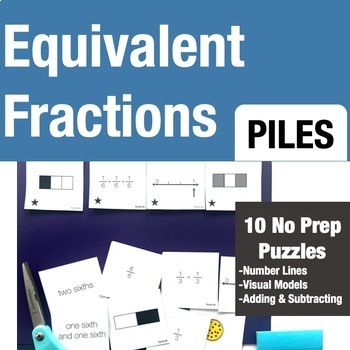Equivalent Fraction Practice: Using Visual Models, Number Lines & Equations
- PDF
Description
Finally! Get all of your students up to speed with equivalent fractions without tears, blank stares or needing to use tricks. These 10 thoughtful no prep puzzles to bring all of your lessons on equivalent fractions together, connecting all different representations!
All you need to do is print, and the students cut and solve. Every time I do this with a class, the students BEG for more puzzles. This is a highly engaging task for your early finishers, for enrichment, gifted students or to use for a whole class math activity.
In this activity, students cut out and find the star "anchor" cards. Then, they put the rest of the cards into piles that match the anchor card. There may not always be the same number of cards in every pile, ensuring that they need to think instead of just find a match.
In these puzzles students will make sense of fractions by finding equivalent fractions in a variety of ways. The puzzles start out with basic benchmark fractions using visual models and real world connections. Then, as the puzzles become more difficult, they begin comparing fractions with the same denominator, comparing fractions on a number line, working with fractions greater than one, and adding and subtracting fractions with like denominators. This is all under the umbrella of trying to find equivalent fractions.
Reasons you may want to try out Piles:
1. Students do NOT understand the Equal Sign. They think it means “the answer is”. This activity will totally challenge that thinking.
2. Students are used to having a pair in a matching game/activity. This mentality won’t work for Piles. They won’t always make a pair, sometimes their pile may have 3 or even 4 cards.
3. For years I’ve watched students thinking that the visual model, number sentence and words are separate things in mathematics. Piles will help connect this for them.
4. This will get them talking! Even your struggling students will start talking about why things fit together, and why they absolutely do not.
5. The activity can be done independently alongside your teaching.
6. You will uncover, and squash all KINDS of misconceptions that you didn’t even know existed.
What age group is this for?
This would be most appropriate for students beginning to learn about fractions, third graders who are advanced could handle the later puzzles, and fourth graders. I currently use the first five puzzles for fourth grade intervention activities, but the second five puzzles could be used for beginning fifth graders.
Why work on equality activities?
So many students misunderstand what the equal sign means. A big misconception is that the equal sign means “the answer is”, when in reality it means something more like “is the same as” or “the same amount as”. Fixing this misconception at an early age will be beneficial in higher level mathematics.
In addition, the Standards for Mathematical Practice put a focus on the thinking processes of students. There is also some pretty strong research suggesting that students should be engaged in math talk for at least 60% of your math lesson. Giving students these tasks allows them to form their own thoughts, and then work with a team to defend their thinking. If you make it a regular part of your classroom routine (once a week or every other week) students will become more comfortable with math talk. The puzzles are also fantastic problem solving, critical thinking and deduction activities. This is also a wonderful test prep activity since the Smarter Balanced Assessment Consortium (SBAC) and Partnership for Assessment of Readiness for College and Careers (PARCC) assessments are heavy with problems in which students are asked to think flexibly.
How long does this activity last?
Depending on the ability level of your students, each individual activity can take anywhere from 10 to 20 minutes (the later puzzles take much longer). In this resource, there are 10 total puzzles with 12 cards to “match” into piles.
How do I assess this project?
You can assess what the students do individually if you have them create their own piles. If you pull together small groups, you could also assess students on their group work skills and level of participation in their group.
How and when do you use this problem type in class?
There are many ways you can use this activity:
- Fast finisher activity
- Morning work
- Intervention block activity
- Small group work
- Homework for students
- Gifted and talented small groups
- Whole class activity
- Parent volunteers can work one on one
- Center activity
Included in this resource:
Information for the teacher pages: CCSS alignment, and a sample lesson plan.
10 puzzles, and 10 answer keys: the puzzles cover equivalent fractions at the most basic level, but it becomes harder as you continue on. Eventually students are finding equivalent fractions by adding fractions with unlike denominators.
These puzzles are challenging, and fun! If you have any questions, or find any problems with your purchase, please contact me as soon as possible so that I may fix any errors.
If you like this activity, try out my reasoning puzzles:





